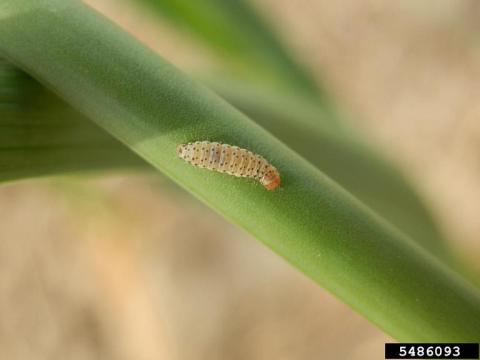Leek Moth Survey for Onion & Garlic Growers

Let us know if leek moth is affecting you by responding to this survey: https://forms.gle/wFeoqPcxERrF7aAe8
While leek moth is not found in most of New Hampshire, this invasive moth attacks members of the onion family in northern Vermont, New York state, and parts of Canada.
The second leek moth flight of the season has begun throughout much of Vermont. Adult leek moths mate at night, laying eggs on all alliums. Shortly thereafter, you will begin to see the characteristic windowpane feeding damage of the leek moth caterpillars. The next generation, resulting from the second flight, have the potential to do significant damage to allium bulbs due to the timing of this larval generation. If these leek moth caterpillars are feeding on allium leaves at the time of harvest, the caterpillars will move into the bulbs as the leaves die down. Feeding damage and exit holes on bulbs while in storage can significantly reduce their marketability and open the bulbs up to secondary infection.
The Vermont Entomology Participatory Action Research Team (VEPART) recently began a NE-SARE funded project exploring pre- and post-harvest tactics for reducing the impact of leek moth in the Northeast. The results of this project will hopefully provide farmers with adaptable and affordable low-tech options for managing leek moth in allium crops. Furthermore, the development of non-chemical options for the control of leek moth will help reduce the dependency on chemical controls and helps to diversify the current IPM toolbox for more sustainable control of the leek moth. Please take a moment to complete the following survey (https://forms.gle/wFeoqPcxERrF7aAe8), it will greatly improve our ability to help growers in the Northeast.
The few known management options include covering plants with row cover at night to exclude the nocturnal female moths from laying eggs. Where this is not feasible or cost effective, chemical controls should be applied. Spinosad (Entrust, organic) and spinetoram (Radiant SC, conventional) have been shown to be effective chemical controls but must time timed appropriately, especially in onions because of caterpillar feeding behavior. Canadian research has consistently found that properly timed insecticide applications made 7-10 days following a peak flight of leek moth adults can effectively manage damage resulting from the following larval generation. For more information about leek moth check out the newly-updated leek moth information center website (https://nysipm.cornell.edu/agriculture/vegetables/leek-moth-information-center/).
If you have any questions or concerns about leek moth please contact Vic Izzo at vizzo@uvm.edu and/or Scott Lewins at slewins@uvm.edu.
Extension Services & Tools That Help NH Farmers Grow
Newsletters: Choose from our many newsletters for production agriculture
Receive Pest Text Alerts - Text UNHIPM to (866) 645-7010
